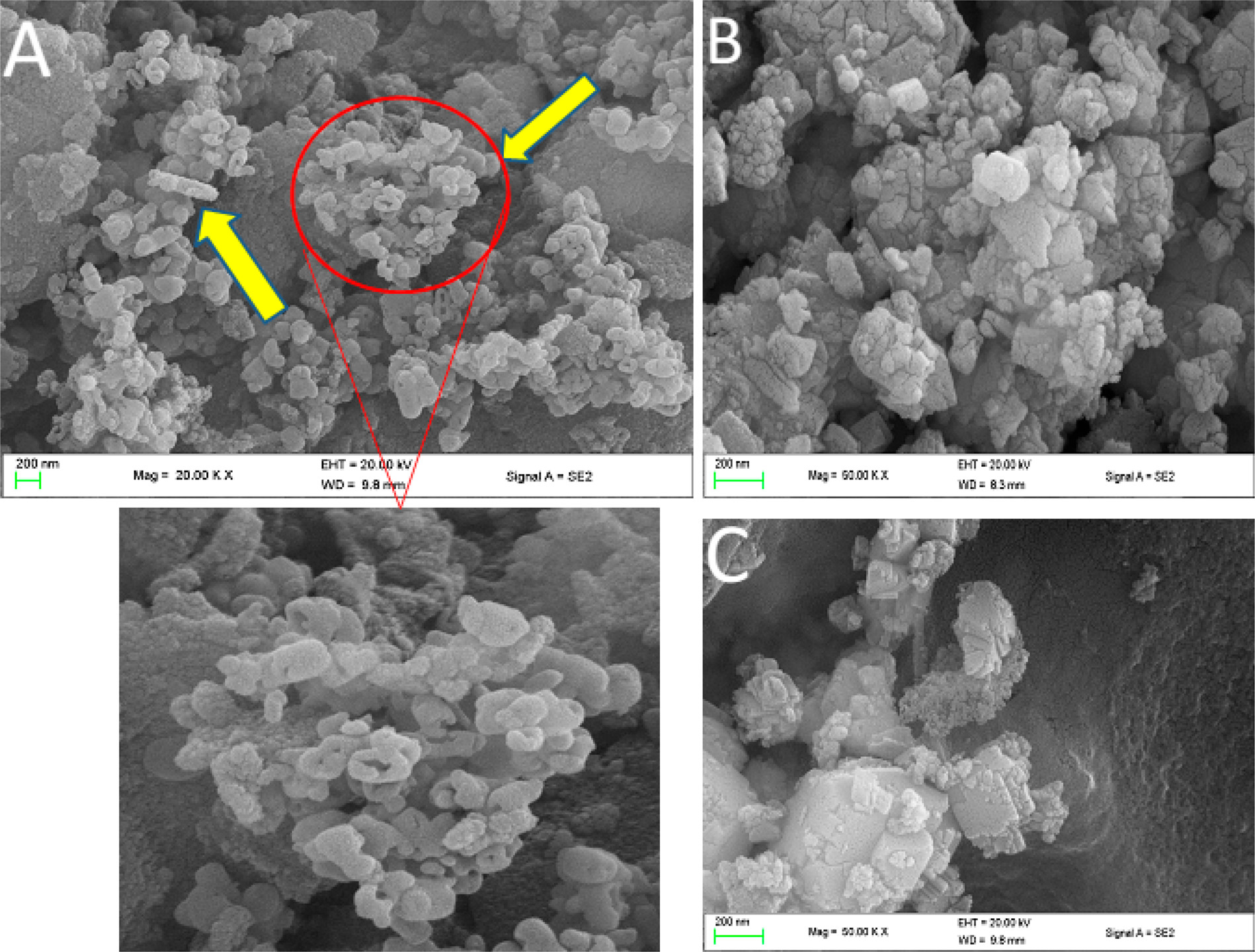Visible-light-mediated photodynamic water disinfection @ bimetallic-doped hybrid clay nanocomposites.
UGWUJA, Chidinma G.; ADELOWO, Olawale O.; OGUNLAJA, Aemere; OMOROGIE, Martins O.; OLUKANNI, Olumide D.; IKHIMIUKOR, Odion O.; IERMAK, Ievgeniia; KOLAWOLE, Gabriel A.; GUENTER, Christina; TAUBERT, Andreas; BODEDE, Olusola; MOODLEY, Roshila; INADA, Natalia Mayumi; DE CAMARGO, Andrea Simone Stucchi; UNUABONAH, Emmanuel I.
UGWUJA, Chidinma G.; ADELOWO, Olawale O.; OGUNLAJA, Aemere; OMOROGIE, Martins O.; OLUKANNI, Olumide D.; IKHIMIUKOR, Odion O.; IERMAK, Ievgeniia; KOLAWOLE, Gabriel A.; GUENTER, Christina; TAUBERT, Andreas; BODEDE, Olusola; MOODLEY, Roshila; INADA, Natalia Mayumi; DE CAMARGO, Andrea Simone Stucchi; UNUABONAH, Emmanuel I.
 Abstract: This study reports a new class of photocatalytic hybrid clay nanocomposites prepared from low-cost sources (kaolinite clay and Carica papaya seeds) doped with Zn and Cu salts via a solvothermal process. X-ray diffraction analysis suggests that Cu-doping and Cu/Zn-doping introduce new phases into the crystalline structure of Kaolinite clay, which is linked to the reduced band gap of kaolinite from typically between 4.9 and 8.2 eV to 2.69 eV for Cu-doped and 1.5 eV for Cu/Zn hybrid clay nanocomposites (Nisar, J.; Århammar, C.; Jämstorp, E.; Ahuja, R. Phys. Rev. B2011, 84, 075120). In the presence of solar light irradiation, Cu- and Cu/Zn-doped nanocomposites facilitate the electron?hole pair separation. This promotes the generation of singlet oxygen which in turn improves the water disinfection efficiencies of these novel nanocomposite materials. The nanocomposite materials were further characterized using high-resolution scanning electron microscopy, fluorimetry, thermogravimetric analysis, and Raman spectroscopy. The breakthrough times of the nanocomposites for a fixed bed mode of disinfection of water contaminated with 2.32 × 10 7 cfu/mL E. coli ATCC 25922 under solar light irradiation are 25 h for Zn-doped, 30 h for Cu-doped, and 35 h for Cu/Zn-doped nanocomposites. In the presence of multidrug and multimetal resistant strains of E. coli, the breakthrough time decreases significantly. Zn-only doped nanocomposites are not photocatalytically active. In the absence of light, the nanocomposites are still effective in decontaminating water, although less efficient than under solar light irradiation. Electrostatic interaction, metal toxicity, and release of singlet oxygen (only in the Cu-doped and Cu/Zn-doped nanocomposites) are the three disinfection mechanisms by which these nanocomposites disinfect water. A regrowth study indicates the absence of any living E. coli cells in treated water even after 4 days. These data and the long hydraulic times (under gravity) exhibited by these nanocomposites during photodisinfection of water indicate an unusually high potential of these nanocomposites as efficient, affordable, and sustainable point-of-use systems for the disinfection of water in developing countries. Abstract: This study reports a new class of photocatalytic hybrid clay nanocomposites prepared from low-cost sources (kaolinite clay and Carica papaya seeds) doped with Zn and Cu salts via a solvothermal process. X-ray diffraction analysis suggests that Cu-doping and Cu/Zn-doping introduce new phases into the crystalline structure of Kaolinite clay, which is linked to the reduced band gap of kaolinite from typically between 4.9 and 8.2 eV to 2.69 eV for Cu-doped and 1.5 eV for Cu/Zn hybrid clay nanocomposites (Nisar, J.; Århammar, C.; Jämstorp, E.; Ahuja, R. Phys. Rev. B2011, 84, 075120). In the presence of solar light irradiation, Cu- and Cu/Zn-doped nanocomposites facilitate the electron?hole pair separation. This promotes the generation of singlet oxygen which in turn improves the water disinfection efficiencies of these novel nanocomposite materials. The nanocomposite materials were further characterized using high-resolution scanning electron microscopy, fluorimetry, thermogravimetric analysis, and Raman spectroscopy. The breakthrough times of the nanocomposites for a fixed bed mode of disinfection of water contaminated with 2.32 × 10 7 cfu/mL E. coli ATCC 25922 under solar light irradiation are 25 h for Zn-doped, 30 h for Cu-doped, and 35 h for Cu/Zn-doped nanocomposites. In the presence of multidrug and multimetal resistant strains of E. coli, the breakthrough time decreases significantly. Zn-only doped nanocomposites are not photocatalytically active. In the absence of light, the nanocomposites are still effective in decontaminating water, although less efficient than under solar light irradiation. Electrostatic interaction, metal toxicity, and release of singlet oxygen (only in the Cu-doped and Cu/Zn-doped nanocomposites) are the three disinfection mechanisms by which these nanocomposites disinfect water. A regrowth study indicates the absence of any living E. coli cells in treated water even after 4 days. These data and the long hydraulic times (under gravity) exhibited by these nanocomposites during photodisinfection of water indicate an unusually high potential of these nanocomposites as efficient, affordable, and sustainable point-of-use systems for the disinfection of water in developing countries. | |
| ACS Applied Materials and Interfaces |
| v. 11, n. 28, p. 25483-25494 + S1-S11 - Ano: 2019 |
| Fator de Impacto: 8,456 |
| http://dx.doi.org/10.1021/acsami.9b01212 |  @article={002953030,author = {UGWUJA, Chidinma G.; ADELOWO, Olawale O.; OGUNLAJA, Aemere; OMOROGIE, Martins O.; OLUKANNI, Olumide D.; IKHIMIUKOR, Odion O.; IERMAK, Ievgeniia; KOLAWOLE, Gabriel A.; GUENTER, Christina; TAUBERT, Andreas; BODEDE, Olusola; MOODLEY, Roshila; INADA, Natalia Mayumi; DE CAMARGO, Andrea Simone Stucchi; UNUABONAH, Emmanuel I.},title={Visible-light-mediated photodynamic water disinfection @ bimetallic-doped hybrid clay nanocomposites},journal={ACS Applied Materials and Interfaces},note={v. 11, n. 28, p. 25483-25494 + S1-S11},year={2019}} @article={002953030,author = {UGWUJA, Chidinma G.; ADELOWO, Olawale O.; OGUNLAJA, Aemere; OMOROGIE, Martins O.; OLUKANNI, Olumide D.; IKHIMIUKOR, Odion O.; IERMAK, Ievgeniia; KOLAWOLE, Gabriel A.; GUENTER, Christina; TAUBERT, Andreas; BODEDE, Olusola; MOODLEY, Roshila; INADA, Natalia Mayumi; DE CAMARGO, Andrea Simone Stucchi; UNUABONAH, Emmanuel I.},title={Visible-light-mediated photodynamic water disinfection @ bimetallic-doped hybrid clay nanocomposites},journal={ACS Applied Materials and Interfaces},note={v. 11, n. 28, p. 25483-25494 + S1-S11},year={2019}} |



